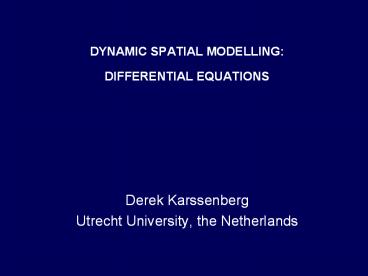DYNAMIC SPATIAL MODELLING: PowerPoint PPT Presentation
1 / 41
Title: DYNAMIC SPATIAL MODELLING:
1
- DYNAMIC SPATIAL MODELLING
- DIFFERENTIAL EQUATIONS
- Derek Karssenberg
- Utrecht University, the Netherlands
2
model development cycle
- .
One approach differential equations
3
introduction
- Differential equations
- in dynamic models
- give rate of change
- mainly point functions
- often used in model structure
- vegetation growth
- flow of water into or out of storages
- radio-active decay
- etc, etc
- need to be integrated to be used in a model
- analytical
- numerical
4
model development cycle
- .
Differential equation
Numerical solution of differential equation
5
example
- What is a differential equation?
6
example
- Example interception storage
- y amount of water in interception storage (m)
- k fraction of water in the interception storage
that leaves the interception storage per second
(s-1, negative value) - time step length (s)
7
example
- Example interception storage
- k -0.002 s-1
- y(0) 0.05 m
y(m)
8
example
- Example interception storage
- red line
- k -0.002 s-1
- y(0) 0.05 m
- yellow line
- k -0.008 s-1
- y(0) 0.05 m
y(m)
9
example
- Example interception storage
- Can be rewritten
10
example
- Example interception storage
- By taking the limit
11
example
- Example interception storage
- is mostly written as
- This is a differential equation because it
involves the derivative - Of the unknown function
12
example
- Example interception storage
- Note that
- Can be written as
- Interpretation both sides of give the rate of
change
13
example
- Example interception storage
- or
- Interpretation
- both sides of
- give the rate of
- change
- Graphical the slope
y(m)
14
solving
- Solving the differential equation
- In a model, the differential equation
- Needs to be solved to get a function
- (in a model, t can be filled in for any time step
and we get y)
15
solving
- Solving the differential equation
- Solving a differential equation can be done in
two ways - Analytical
- Numerical mathematics
16
Analytical solution
- Example, analytical solution initial value
problem - The solution of the initial value problem
- Is (by integration)
- With
- yi initial condition of y (at t0), i.e. initial
amount of water in - interception store
17
Analytical solution
- Analytical solution
- k-0.002 fraction output from
canopy (s-1)Dt60 timestep (s)
timesteps 60initial YZeroscalar(0.05)
dynamic Ttime()Dt - YYZeroexp(Tk) Y is not on right side !!
report ana.tssY
18
Analytical solution
- Analytical solution
- k-0.002 fraction output from
canopy (s-1)Dt60 timestep (s)
timesteps 60initial YZeroscalar(0.05)
dynamic Ttime()Dt - YYZeroexp(Tk) Y is not on right side !!
report ana.tssY
y(m)
19
Numerical solution
- Often, numerical solutions are used
- Many differential equations cannot be solved
analytically - Numerical solutions are relatively simple to
program (not all) - Numerical solutions are sufficiently precise for
most applications - Modellers cant do maths...
20
Numerical solution
- Many numerical solution algorithms are available
- Euler method
- Heuns method
- Runge-Kutta method
21
Euler
- Euler method or Euler-Cauchy method
- The solution of the initial value problem
- Is (Euler or Euler-Cauchy method)
- with
- time step length
22
Euler
- Euler method or Euler-Cauchy method, example
- We have the initial value problem
- The solution is (Euler or Euler-Cauchy method)
- Note this is how we solved it initially
23
Euler
- Euler method or Euler-Cauchy method, example
- k-0.002 fraction output from
canopy (s-1)Dt60 timestep (s)
timesteps 60initial YZeroscalar(0.05)
YYZerodynamic YYDtkY report
euler.tssY
24
Euler
- .
y(m)
t(s), x 60
25
Euler
- .
absolute error (m)
t(s), x 60
26
Euler
- .
relative error ()
t(s), x 60
27
Heun
- Heuns method
- The solution of the initial value problem
- is
- with
- (note is calculated
with Eulers method)
28
Heun
- Heuns method, example
- We have the initial value problem
- The solution is (Euler or Euler-Cauchy method)
- with
29
Heun
- Heuns method, example
- k-0.002 fraction output from
canopy (s-1)Dt60 timestep (s)
timesteps 60initial YZeroscalar(0.05)
YYZerodynamic YStarYDtkY
YYDt((kYkYStar)/2) report heun.tssY
30
Heun
- .
y(m)
t(s), x 60
31
Heun
- .
absolute error (m)
t(s), x 60
32
Heun
- .
absolute error (m)
t(s), x 60
33
Heun
- .
relative error ()
t(s), x 60
34
Runge-Kutta
- Classical Runge-Kutta method of 4th order
- calculate four auxilliarry variables
- derive new value from these
- small numerical error, easy to program
35
Runge-Kutta
- Classical Runge-Kutta method of 4th order
- We have the initial value problem
- The solution is
36
Runge-Kutta
- Runge-Kutta method, example
- k-0.002 fraction output from
canopy (s-1)Dt60 timestep (s)
timesteps60 - initial YZeroscalar(0.05) YYZerodynamic
KOneDt(kY) KTwoDt(k(Y0.5KOne))
KThreeDt(k(Y0.5KTwo)) KFourDt(k(YKThree
)) YY(1/6)(KOne2KTwo2KThreeKFour)
report runga.tssY
37
Runge-Kutta
- .
y(m)
t(s), x 60
38
Runge-Kutta
- .
absolute error (m)
t(s), x 60
39
Runge-Kutta
- .
relative error ()
t(s), x 60
40
remarks
- Some conclusions, final remarks
- in many cases, euler method can be used (and is
used) - when precision is important, use Runge-Kutta
- Not all diff. equations can be solved with
Runge-Kutta! - - For complicated problems, use pre-programmed
software - Example MODFLOW
41
literature
- Literature Kreyszig
- Kreyszig (1999) sheets
- h
- x t
- yn1
- You could read
- automatic step size selection (p 945)
- proof of local error (p 947)
- error and step size control (p 949)

